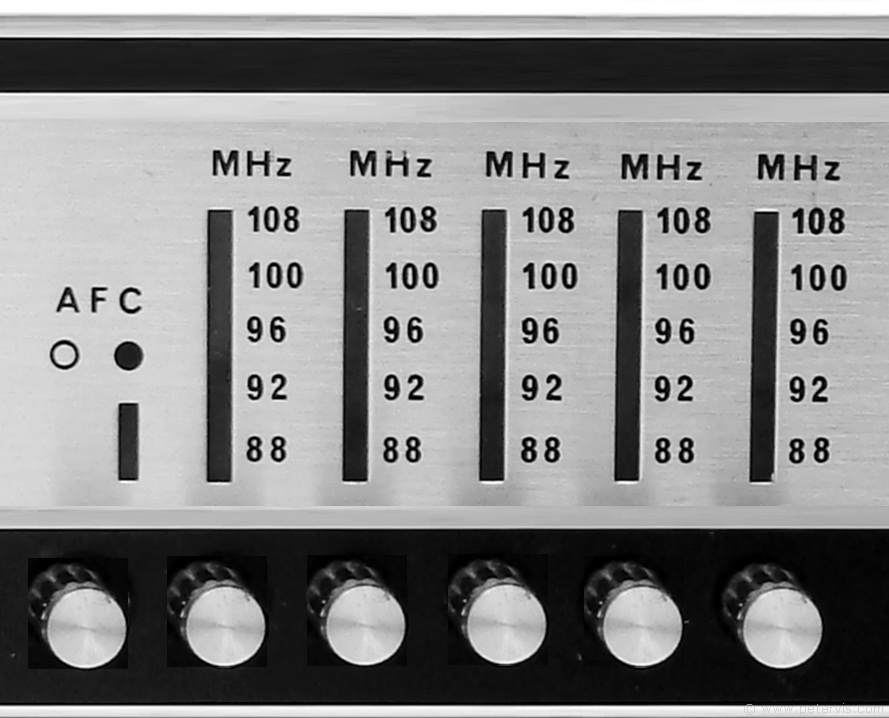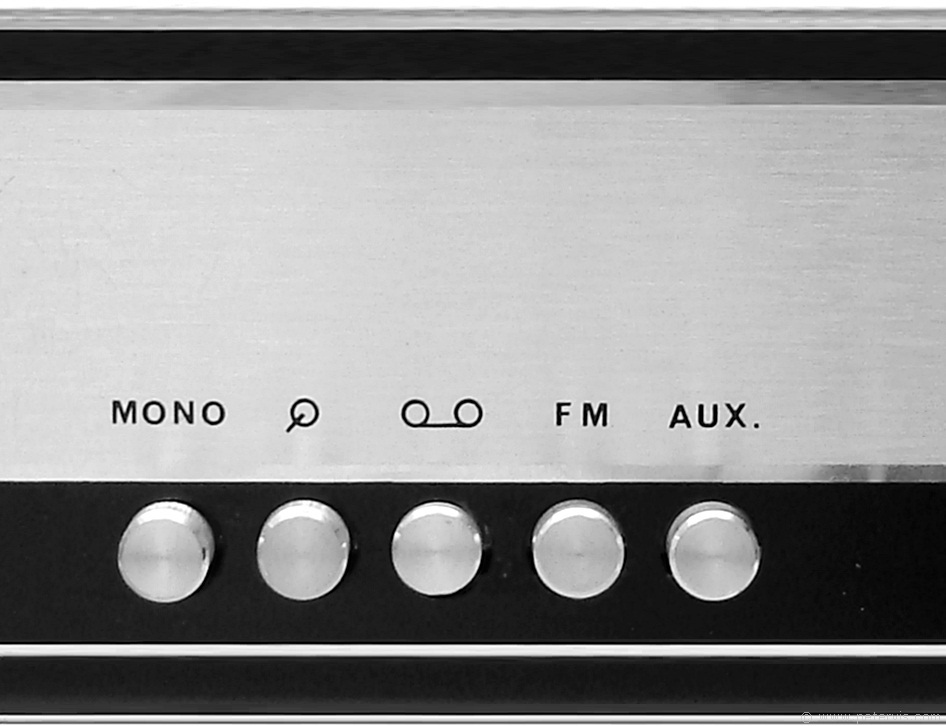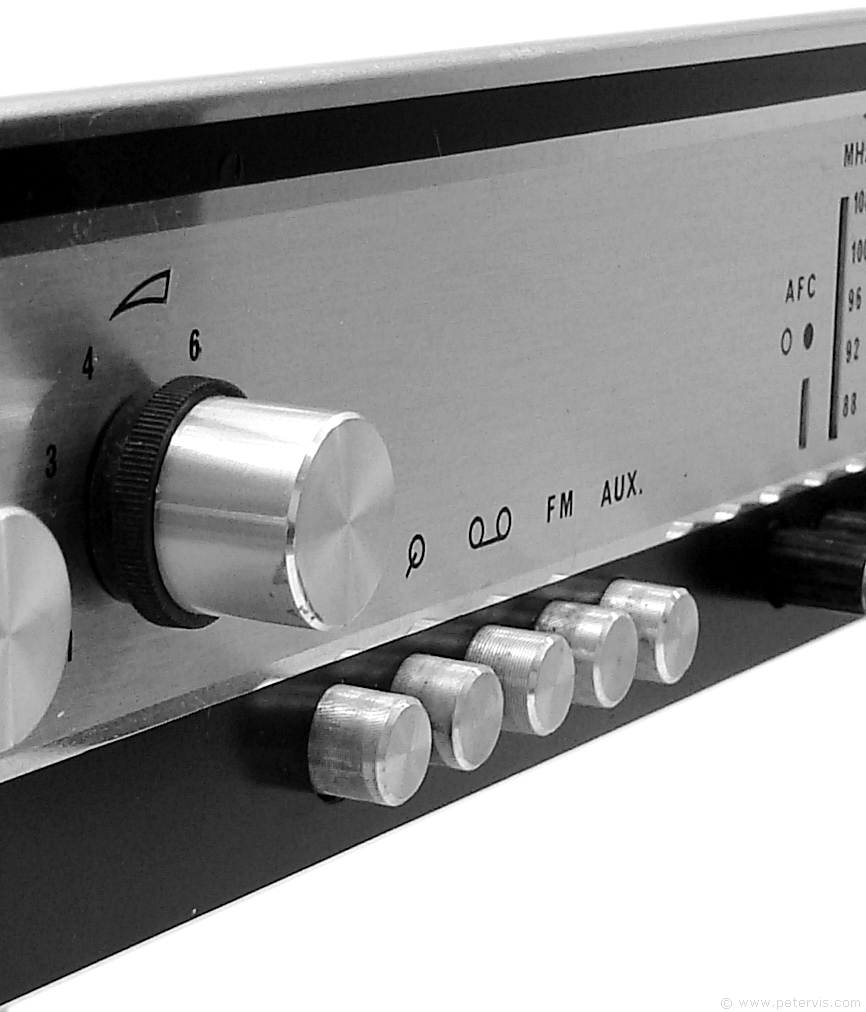HMV Model 2404

HMV Model 2404 is a stereo FM receiver/Amplifier manufactured by The British Radio Corporation London, England. It is part of the HMV 2400 series of amplifiers which were very popular in gramophones at that time. HMV at that time was part of the Thorn group of companies that manufactured consumer electronics for export to the rest of the world. This amplifiers power output was 15-watts per channel into 4 Ω speakers. The power output stage consists of a pair of AL102 transistors in each channel. At the back, it has 4 DIN sockets for auxiliary, tape, magnetic, and ceramic/crystal inputs. There is no tuning scale for the radio, and instead it has facility for four preset tuning, and an AFC switch. The FM radio is all discrete transistor based including the multiplex circuitry. This amplifier looks very similar to the HMV Model 2401 Stereomaster which would have been installed as a chassis into a large radiogram style cabinet.
The AL102 transistors are Germanium PNP type with collector current (Ic) rating of 6 A, and power dissipation rating of 30-watts. They are in the TO3 package that is becoming very popular in recent years due to the J. L. Linsley Hood Class A amplifier article in Wireless World. These days, almost any power transistor in the TO3 package is expensive because many hobbyists are interested in making a Class A amplifier with them.
Review

There is no tuning scale or dial for the FM radio, and instead they have equipped it with five individually tuneable presets. It is a lovely simple design that works well and does away with the overhead of having a scale plate, and tuning string mechanism.


This particular amplifier was in a very rough cosmetic state and nobody wanted it at the auction site. I noticed the diamond shaped covers at the back and recognised that behind those covers there should be TO-3 power transistors. I had just recently tried to buy similar power transistors in the TO-3 package from China and they turned out to be fakes, so I figured that even if I could get some genuine vintage transistors out of it, then it would be worth paying ten pounds or so.
Unfortunately it was sent in one layer of bubble wrap, and the courier had managed to break the wooden cabinet. One side of the front panel was bent and warped as if someone had parked a lorry over it. I straightened the front panel as best I could, but it still looked warped!
After some basic electrical checks and repair, it seemed safe to plug it in for testing. Obviously, the FM radio was not working as I had anticipated, as many of the old germanium components would be well past their useful service life. There was also a hairline crack on the board; hence unfortunately it was a lost cause. However the amplifier board was working fine and I sent some audio signals from my walkman to the auxiliary DIN socket. I had a pair of cheap test speakers connected to it and was very pleasantly surprised with the sound quality which had very crisp treble and creamy bass. One interesting feature I noticed was how large the cone displacement was when I turned up the bass. It leads me to conclude that this amplifier was designed to work with a set of large HMV cabinet speakers that usually came with it as a set. It was very likely part of a matching hi-fi suite consisting of the HMV Model 2405 Lenco Turntable.
I grew up reading those expensive glossy hi-fi magazines; hence if someone had told me that germanium transistors could sound good, I probably would have scoffed, but after listening to this amp, I am a convert. I was totally blown away with the sound quality and specifically the low frequency bass response, which is very powerful even at low volumes. When I connected a pair of midrange JPW speakers, the sound produced was nothing like I have ever heard before. There was a lovely resonant bass, and I must have spent half the day just standing and listening to it. I liked it so much that this amp has now taken permanent place of my previous amp. Only one problem is that I need to get some more DIN to RCA phono cables.

With mechanical input selector switches, the input signal remains unadulterated in this lovely pure analogue amplifier system. In contrast, with modern amplifiers the signal is usually fed to a switching IC and then to a signal processor IC.
Cost/eBay
These amplifiers are rarely seen for sale due to their age, and the number of survivor models left. A burnt amp on its own is not worth much because the replacement germanium transistors are difficult to source and expensive. It is also very complicated to repair and replacing the audio power output transistors time consuming, and for that reason, a damaged one would not be worth more than ten to twenty pounds. However a unit in good working order that simply requires a service and recap is worth over fifty pounds and more on a good. If you have the amplifier together with the original suite consisting of cabinet speakers, turntable, and tape deck, then you have likely hit the jackpot and can get a couple of hundred pounds or more from the right buyer. Before you rush off to eBay to see if an amplifier like this exists for sale, take the time to have a look at the inside electronic engineering of this amp through the pages listed below.
This Article Continues...
HMV Model 2404Electronic Engineering
Servicing
Vintage Potentiometers
Power Amplifier
FM Radio Circuitry
Pre-Amplifier
Back Panel
Power Supply
